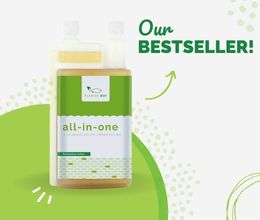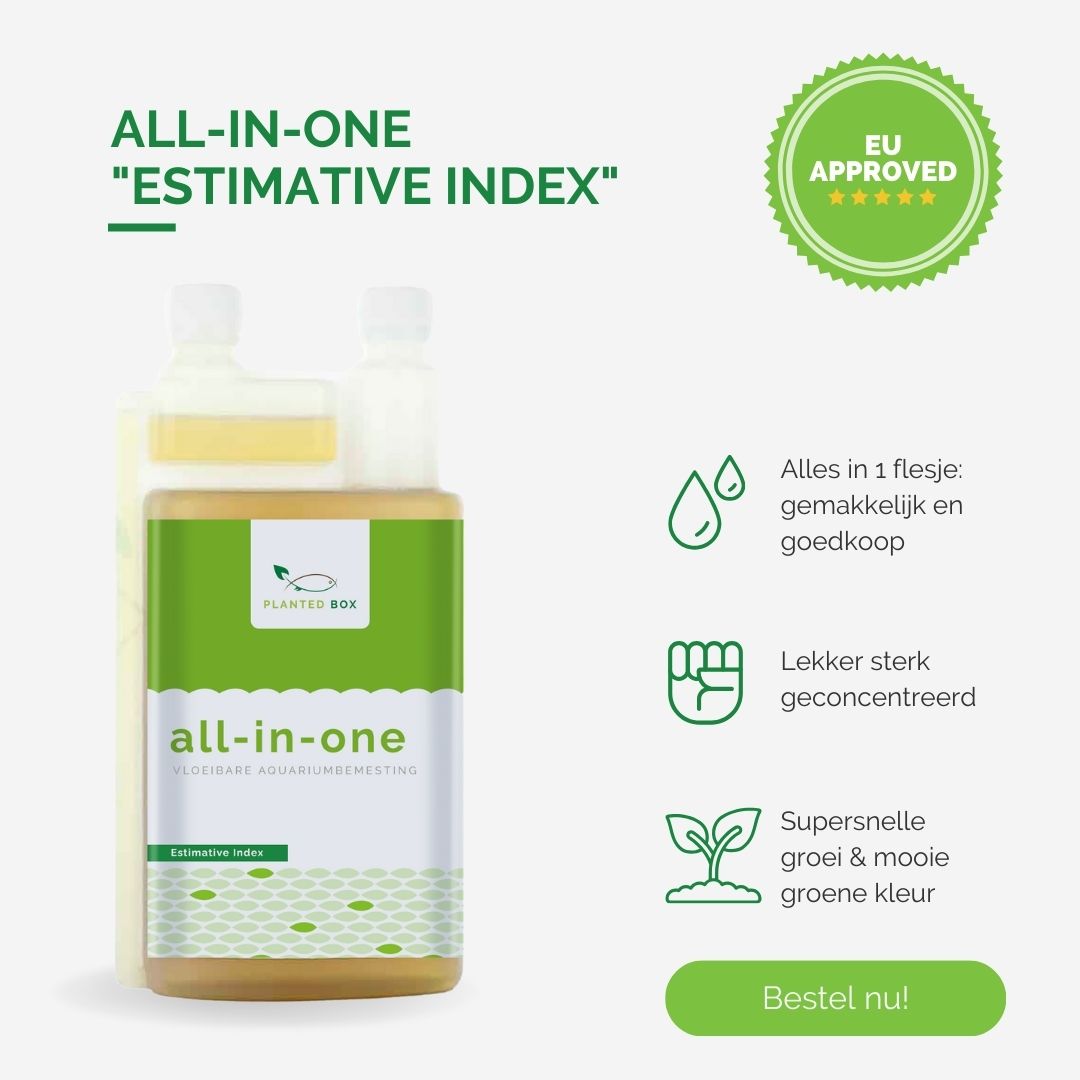I get emails about aquarium plant fertilizers every day. Makes sense, since my best-selling product is my All-in-One complete aquarium fertilizer.
To make the key aspects of aquarium plant food clearer for you, I’ve grouped everything into this handy article. All these questions are covered in this comprehensive guide: Frequently asked questions about aquarium plant fertilizers & how to use them.
- Do aquarium plants actually need fertilizer?
- Why do they need aquarium fertilizer?
- What’s the difference between micro & macro-nutrients for plants?
- Are phosphate and nitrate necessary?
- Which plants benefit from liquid fertilizers?
- Is there fertilizer specifically for the roots?
- How much aquarium fertilizer should you add?
- How often should you dose fertilizer?
- What is the best aquarium plant fertilizer?
- Conclusion
It might all sound a bit complicated, but with this detailed explanation, you’ll be a pro in no time!
Frequently Asked Question #1: Do aquarium plants need fertilizer?
The short answer? Yes, they do. But let me explain why.
Your aquarium naturally contains some minerals and nutrients. These come from your tap water, substrate, aquasoil, and the breakdown of waste by bacteria. The problem is, most tanks today use strong lighting, which makes plants grow faster but also increases their need for nutrients and CO2. This means that the naturally available CO2 and nutrients are often insufficient, leading to algae growth and nutrient deficiencies.
Especially if you have a heavily planted aquarium (like an aquascape or a Dutch-style aquarium) with intense lighting and weekly water changes…

If your tank has LEDs or T5 lighting and you want to prevent nutrient deficiencies and algae, I recommend adding aquarium plant fertilizer. When don’t you need it? If you barely have any plants (like in a cichlid tank) or use very weak lighting (e.g., an old T8 lamp), the natural nutrients might be enough.
Question #2: Why do aquarium plants need fertilizer?
Well, I already touched on this. In your aquarium, you need to maintain a certain balance—the so-called nutrient triangle:

Your lighting, CO2, and nutrients need to be in balance for healthy plant growth. If one is missing, the triangle collapses, leading to poor plant growth and algae. This happens when:
- You have way too much aquarium lighting compared to the CO2 & nutrients you add (this happens a lot!)
- You add too little or no aquarium plant food
- Your CO2 levels aren’t right
If you want vibrant leaves and intense colors, keeping this triangle in balance is key.
Question #3: What are micro & macro nutrients?
Aquarium fertilizers can be divided into:
- Macro elements: These include phosphate, nitrate, potassium, and carbon. They’re crucial for plant growth, which is why they’re called “macro” elements. If any of these are lacking, you’ll notice it quickly.
- Micro elements: These nutrients are needed in tiny amounts but are just as essential. Examples include zinc, iron, copper, boron, manganese, and molybdenum.
Do you need to add all these separately? No, of course not! The easiest solution is my All-in-One aquarium plant fertilizer, which contains both macro and micro nutrients in a single bottle—super convenient.
If you prefer to dose Micro & Macro separately, you can do that too. However, most aquarists prefer the convenience of my complete aquarium fertilizer.
PS: Want to learn more about the symptoms of nutrient deficiencies? Read my article about it.
Question #4: Do my aquarium plants need phosphate and nitrate?
Yes, as mentioned before, both of these are macro-elements and super important for healthy plant growth. Sometimes, your tank might already have high nitrate and phosphate levels. This can happen if you add a lot of fish food that ends up rotting, have a large fish population, or if your tap water contains a lot of nitrate and phosphate. In that case, you might choose to only add Micro nutrients.

Keep in mind that if your tank naturally has a lot of nitrate & phosphate, it often means there’s too little maintenance and too much waste in your tank. This usually comes from decaying plant matter and fish waste, which bacteria break down into nitrate & phosphate.
You want to keep waste in your water to a minimum (since that can cause algae, while aquarium fertilizers don’t). So, I recommend improving your maintenance routine and doing more frequent water changes.
Question #5: How do my plants absorb liquid fertilizer?
Aquarium plants absorb nutrients through their leaves or roots. Plants that live underwater, like aquarium plants, have specially adapted leaf structures that allow even better nutrient absorption.
These plants have evolved in such a way that very little nutrient transport is needed because they absorb nutrients over almost their entire surface. That’s why your plants tend to wilt quickly if they’re left out of the water for too long.

Question #6: Is there aquarium plant fertilizer specifically for the roots?
Almost all aquarium plants absorb nutrients through their leaves, which is why you can use liquid aquarium plant fertilizers. However, a smaller group of plants, such as Cryptocoryne, primarily absorb nutrients through their roots. For those plants, you can insert fish tank root tabs near their roots, like my Crypto capsules.
It’s good to know that aquarium plants with well-developed roots also take in nutrients through their leaves. The main function of their roots is actually anchoring in naturally flowing water.
And what about nutrient-rich substrate? You can use that too, but honestly, I think it’s a waste of money. A nutrient-rich substrate covers the entire bottom of your tank, while only a few plants actually benefit from it. Most plants absorb nutrients directly from the water column. Instead, it’s better to place fish tank root tabs where the plants truly need them.

Question #7: How much aquarium plant fertilizer should you add?
You can follow the so-called Estimative Index. This method ensures a slight surplus of nutrients so your plants never experience deficiencies and can always thrive.
It’s a bit of trial and error since you also have to consider your tank’s light levels and plant density. The target values are as follows:
- Potassium: 10 – 30 mg/l
- Nitrate: 10 – 30 mg/l
- Phosphate: 1 – 3 mg/l
- Iron & trace elements: 0.5 – 1.5 mg/l
Read my article on “How much fertilizer to add to your aquarium”.
PS: If you’re using my All-in-One plant food for aquarium plants, you have two dosing options: a small dose for low light/no CO2/few plants and a larger dose for high light/CO2/many plants. You can dose weekly, daily, or multiple times per week depending on your schedule and preferences. Best of all, it’s already calibrated to match the recommended amounts above!
Question #8: How often should I dose? Weekly or daily?
With my aquarium plant fertilizer, you can choose how you dose. Theoretically, daily dosing is better because it keeps the nutrient supply stable. However, many of my customers forget to dose daily, which can lead to occasional deficiencies. That’s why I generally recommend weekly dosing to ensure there’s always enough.
Prefer dosing a few times a week? That works too!
Question #9: What is the “best” aquarium plant fertilizer?
Well, I hear this one a lot, and it’s tough to answer. There isn’t one fish tank plant food brand or product that works for every aquarium. But here are some key factors to help you pick the best aquarium plant fertilizer for your setup:
- What’s in the product? Manufacturers are legally required to disclose this to users under European law. If the ingredients aren’t listed, you have no idea what you’re adding to your tank or whether it’s safe for your fish and plants. I’d look elsewhere…
- What’s the dosage (in ppm) and concentration? These can vary significantly.
- Who produces it? A reliable aquarium brand or a random supplier? Buying from an unknown source may be cheaper, but do you really know what you’re getting? Is it safe for your fish and plants? That’s why strict regulations exist to ensure safety!
- Are there reviews & videos available about the product?
- What support do you get along with the fertilizer? Plant growth is affected by many factors—does the manufacturer help you with that?
I can confidently say that all my fertilizers are approved by the European Union (covering raw materials, production & storage, safety protocols, traceability from raw material to end-user, etc.), and my customers are happy with both the product and advice, as seen in the reviews.
Conclusion
Aquarium plant fertilizers are essential.
The right nutrients lead to better plant growth, more vibrant colors, and healthier plants. In other words, your tank will look alive instead of dead. And let’s be honest—that’s the goal, right?
It’s important to understand what you’re doing and ensure all nutrients are present in sufficient amounts. If even one is missing, your plants will suffer. Every nutrient mentioned in this post is essential, though they are needed in different amounts.
Do you have questions about plant fertilizers? Struggling with the right dosage? I’m happy to help! Let me know in the comments below!










